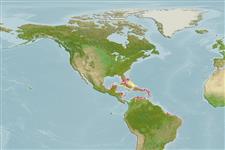Demospongiae |
Haplosclerida |
Chalinidae
Environment: milieu / climate zone / depth range / distribution range
Ecology
Sessile; brackish; depth range 0 - 3 m (Ref. 108813). Tropical
Western Central Atlantic: Caribbean.
Length at first maturity / Size / Weight / Age
Maturity: Lm ? range ? - ? cm Max length : 10.0 cm BRL male/unsexed; (Ref. 415); common length : 1.2 cm BRW male/unsexed; (Ref. 415)
Thin erect branches: 0.2 - 1.2 cm wide, 5 - 10 cm long. Oscula inconspicuous, 0.1 cm wide along branches. Smooth surface. Compressible but fragile in consistency. Whitish gray to purplish externally, tan internally (Ref. 415).
It is an epibiotic species found on submerged vegetation (Ref. 108813). Rare on mangrove roots and peat (Ref. 415).
Life cycle and mating behavior
Maturity | Reproduction | Spawning | Eggs | Fecundity | Larvae
Members of the class Demospongiae are hermaphroditic. Life cycle: The zygote develops into parenchymella larva (free-swimming) before settling down on a substrate where it grows into a young sponge.
Collin, R., M.C. Díaz, J. Norenburg, R.M. Rocha, J.A. Sánchez, M. Schulze, A. Schwartz and A. Valdés 2005 Photographic identification guide to some common marine invertebrates of Bocas Del Toro, Panama. Caribbean Journal of Science. 41(3):638-707. (Ref. 415)
IUCN Red List Status
(Ref. 130435: Version 2025-1)
CITES status (Ref. 108899)
Not Evaluated
Not Evaluated
Threat to humans
Harmless
Human uses
| FishSource |
Tools
More information
Trophic EcologyFood items (preys)
Diet composition
Food consumption
Predators
Population dynamicsGrowthMax. ages / sizesLength-weight rel.Length-length rel.Length-frequenciesMass conversionAbundance Life cycleReproductionMaturityFecunditySpawningEggsEgg developmentLarvae PhysiologyOxygen consumption
Human RelatedStamps, coins, misc.
Internet sources
Estimates based on models
Preferred temperature
(Ref.
115969): 26.4 - 28.2, mean 27.5 (based on 407 cells).
Fishing Vulnerability
Low vulnerability (10 of 100).
Price category
Unknown.
